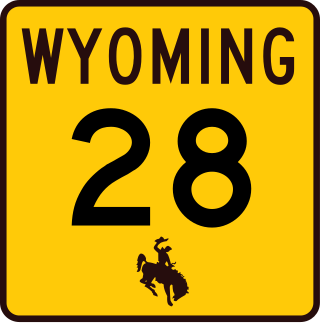Top Qs
Timeline
Chat
Perspective
Wyoming Highway 28
State highway in Sweetwater, Sublette, and Fremont counties in Wyoming, United States From Wikipedia, the free encyclopedia
Remove ads
Wyoming Highway 28 (WYO 28), also known as the South Pass Highway, is a 96.46-mile (155.24 km) state highway in Sweetwater, Sublette, and Fremont counties in Wyoming, United States, that connects Wyoming Highway 372 (WYO 372), southeast of Fontenelle, with U.S. Route 287 / Wyoming Highway 789 (US 287 / WYO 789), south-southeast of Lander.
Remove ads
Route description
Summarize
Perspective
Sweetwater County
WYO 28 begins at a T intersection with WYO 372 (La Barge Road) in Sweetwater County, just north of a western arm of the Seedskadee National Wildlife Refuge (Seedskadee NWR) and roughly 14 miles (23 km) southeast of the census-designated place (CDP) of Fontenelle. (WYO 372 heads north toward Kemmerer and La Barge and south through the arm of the Seedskade NWR and then on toward Green River and Rock Springs.)[2]
From its western terminus WYO 28 proceeds northwesterly as a two lane road for its entire length. After approximately 2.8 miles (4.5 km), WYO 28 enters the Seedskadee NWR, crosses the Green River, and then leaves the Seedskadee NWR. At about 28.82 miles (46.38 km) along its route, and just after crossing the Big Sandy River, WY0 28 has its junction with U.S. Route 191 (US 191) on the southern border of the CDP of Farson in Eden Valley.[3][4] (US 191 heads north toward Pinedale and Jackson and south toward Eden and Rock Springs.)[2][5]
East of its junction with US 191, WYO 28 very briefly passes through the southern edge of Farson before continuing roughly 2.4 miles (3.9 km) along the southern border of the CDP, with the meanders of Little Sandy Creek[6] to the south. As WYO 28 crosses the Little Sandy Creek, it leaves Farson CR 108 and continues for about 14.5 miles (23.3 km) before leaving Sweetwater County.[2][5]
Sublette County
Upon leaving Sweetwater County, WWO 28 enters Sublette County. With the exception of a single paved turnoff, there are only a few unnamed dirt side roads along the 3.75 miles (6.04 km) section of WYO 28 that are within Sublette County. The nearly 1,900-foot (580 m) turnoff includes a historical marker and gravestone.[7] Upon leaving Sublette County, WYO 28 enters Fremont County.
Fremont County
After 5 miles (8.0 km), it spurs north to Farson Little Sandy Road, leading to Big Sandy.[8] It continues northeast out of Sweetwater County, cuts through a small corner of Sublette County and enters Fremont County.[9] It crosses the Continental Divide at South Pass, one of the lowest passes on the continental divide, at 7,550 feet (2,300 m). South Pass was used by settlers on the Oregon Trail. From there, there are spurs to the south leading to the South Pass Historic Site and Atlantic City. From there it curves north, travelling about 17 miles (27 km) until its merge with US 287, near Lander.[citation needed][2]
Remove ads
History
Summarize
Perspective
This section needs expansion. You can help by adding to it. (February 2014) |

WYO 28 generally follows the route followed by settlers on the Oregon Trail.[10] A section of the highway 17 miles (27 km) due south of Lander and just north of the census-designated place of Atlantic City was realigned around a new U.S. Steel mine in 1962. (The mine was known as the Columbia-Geneva Mines.)[11] The realignment created sharp and narrow turns. Although the mine closed in 1983, the section was not removed until the original alignment was restored in 2005.[12]
The western end of WYO 28 was originally at the former U.S. Route 287 (now US 191) in Farson,[7] but was extended southwest to the Fontenelle area in 1986 in response to increased soda ash shipments by truck, which required a paved road.[13] The project was led by the Federal Highway Administration, which was granted the necessary right-of-way by the Bureau of Land Management (BLM); the agreement between the two federal agencies required that any future wildlife fence on the corridor be approved by the BLM.[14] A 15-mile (24 km) was proposed in 1991 to redirect herds of Sublette antelopes as well as livestock which had caused vehicular accidents since the extension opened. The BLM initially approved a plan with the Wyoming Department of Transportation (WYDOT) to fence the corridor, but WYDOT later retracted the plan following public opposition and pushback from the Wyoming Department of Game and Fish.[15] A series of eight warning signs was installed as an alternative to the fencing plan.[16]
Remove ads
Major intersections
Summarize
Perspective
This section is missing mileposts for junctions. |
Actual mileposts begin at 100 at WYO 372 and increase heading northeast to Farson, where they reset to 0 and increase continuing northeast toward Lander.
Remove ads
See also
References
External links
Wikiwand - on
Seamless Wikipedia browsing. On steroids.
Remove ads


